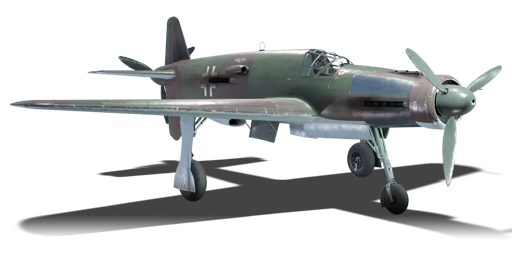



The Do 335 A-1 was intended to be the first mass-produced variant of the series. Compared to the pre-production A-0 variant, it featured uprated DB 603E-1 engines and provisions for bomb racks. However, due to the capture of the Oberpfaffenhofen factory where the A-1 was built in April 1945 by the US Army, none of the aircraft saw service. In total, 11 of the A-1 variant were built.
Introduced in Update 1.57 "Battle March", the Do 335 A-1 is a difficult plane to fly. It has good armament and a very high top speed, however, it lacks anything else of substance. Sub-par climb rate, poor turning and handling, as well as the lack of armour and a propensity to catch fire, make this aircraft unforgiving. On the other hand, the A-1 is effective in close air support thanks to its decent payload, in addition to the powerful AP belts for the 30 mm gun that allow it to crack the tops of enemy tanks with ease.
flaps
flaps
flaps
brake
| Belt | Belt filling | Armor penetration (mm) at a distance: | |||||
|---|---|---|---|---|---|---|---|
| 10 m | 100 m | 500 m | 1000 m | 1500 m | 2000 m | ||
| HEI-T/SAPHEI-T/AP-I | 58 | 55 | 44 | 33 | 25 | 19 | |
| HVAP-T | 77 | 74 | 61 | 47 | 37 | 29 | |
| HEI-T/HEI-T/HEI-T/SAPHEI-T | 38 | 36 | 28 | 20 | 15 | 11 | |
| AP-I | 58 | 55 | 44 | 33 | 25 | 19 | |
| Belt | Belt filling | Armor penetration (mm) at a distance: | |||||
|---|---|---|---|---|---|---|---|
| 10 m | 100 m | 500 m | 1000 m | 1500 m | 2000 m | ||
| AP-T/IT/IT/HEF-T | 33 | 30 | 21 | 13 | 8 | 5 | |
| AP-T/HEF-T/AP-T/HEF-T | 33 | 30 | 21 | 13 | 8 | 5 | |
| AP-I/HEF-T/HEF-T/HEF-T | 34 | 30 | 17 | 8 | 4 | 4 | |
| AP-I(c)/AP-I(c)/AP-I(c)/HEF-T | 51 | 47 | 31 | 19 | 11 | 7 | |
2 × 250 kg SC250JA bomb












Flight performance | |
|---|---|
Survivability |
|---|
Weaponry | ||
|---|---|---|